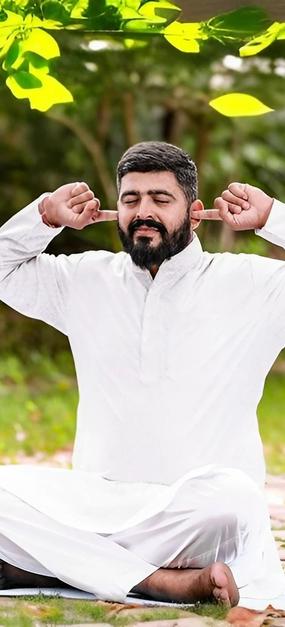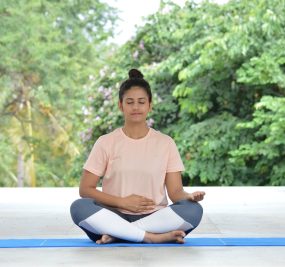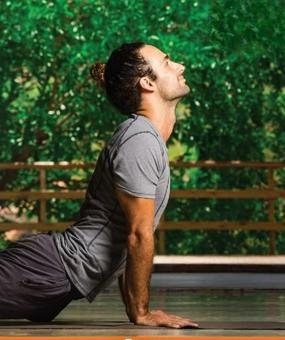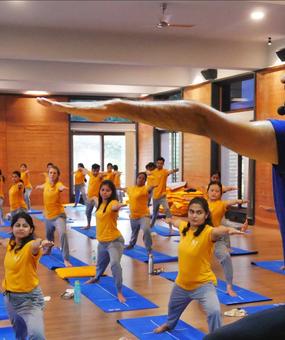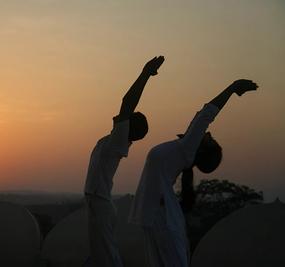For too many people, back pain is more than an occasional annoyance—it’s a chronic condition that affects every aspect of life, from work and sleep to simple everyday movements. The reasons are as varied as the people who experience it: sedentary lifestyles, poor posture, muscle imbalances, and stress.
In our technology-driven world, back pain has reached unprecedented levels, affecting over 619 million people globally and representing the leading cause of disability according to the Global Burden of Disease Study. Yet, thousands of years before MRI scans and prescription opioids, ancient sages developed a comprehensive system for spinal health that modern science is now validating with remarkable precision.
Groundbreaking research from Cleveland Clinic demonstrates that participants in virtual yoga programs experienced six times greater reductions in pain intensity scores and 2.7 times greater improvements in back-related function compared to control groups. A comprehensive meta-analysis in PLOS One involving 756 participants found that yoga significantly reduces chronic nonspecific lower back pain by 0.41 points on standardized scales, providing robust evidence for what Vedic texts have taught for millennia.
The conventional treatments often focus on temporary relief, but what if there was a way to address the root causes and cultivate lasting, sustainable healing? Yoga, an ancient practice backed by modern science, offers a comprehensive and profound solution for achieving a pain-free life.
What This Comprehensive Guide Covers:
- The biomechanics of back pain and how yoga’s holistic approach addresses them.
- The profound connection between ancient Vedic wisdom and modern neuroscience
- How Patanjali’s Yoga Sutras address the root causes of contemporary back pain
- Therapeutic poses with detailed therapeutic applications
What Did Ancient Sages Understand About Spinal Health?
The Vedic Foundation of Spinal Wisdom
The ancient Vedas, dating back over 5,000 years, describe the spine as “Merudanda” – the central axis of human existence, named after Mount Meru, the cosmic mountain at the center of all universes. This poetic imagery reveals a profound understanding: the spine is not merely a physical structure but the foundation for our entire being.
In the Upanishads, specifically the Katha Upanishad (2.3.17), we find: “When all the senses are stilled, when the mind is at rest, when the intellect wavers not – this is called the highest state.” This ancient teaching directly addresses what modern medicine now recognizes as the mind-body connection in pain perception.
Patanjali’s Yoga Sutras, composed around 400 CE, systematically outline how physical discomfort arises from mental disturbances. Sutra 2.46 states, “Sthira sukham asanam” – postures should be steady and comfortable. This isn’t merely about physical positioning; it’s a revolutionary approach that prioritizes inner stability over external achievement.
The Hatha Yoga Pradipika (15th century) elaborates on this wisdom: “Hatha Yoga is a stairway for those who wish to attain the highest Raja Yoga.” Here, “Hatha” (force) doesn’t mean aggressive effort, but rather the balanced union of opposing forces – sun and moon, active and receptive, strength and flexibility.
Modern Science Validates Ancient Understanding
Contemporary neuroscience research published in the Journal of Pain Research demonstrates that yoga practice literally rewires brain structure, increasing gray matter density in regions associated with pain modulation. This validates the Vedic understanding that consciousness and physical experience are inextricably linked.
Dr. Catherine Bushnell’s research at the National Center for Complementary and Integrative Health shows that yoga practitioners have increased cortical thickness in brain regions involved in pain processing, essentially proving that ancient practices create measurable neuroplastic changes.
Why Does Modern Life Create Such Epidemic Back Pain?
The Perfect Storm of Contemporary Living
Our ancestors lived in harmony with natural rhythms – walking, gathering, farming, and resting according to solar cycles. The Ayurvedic principle of “Dinacharya” (daily routine aligned with natural cycles) recognized that disrupting these patterns creates “Vata” imbalance, manifesting as pain and stiffness.
Today’s lifestyle creates multiple imbalances:
Structural Collapse: Average office workers sit 10+ hours daily, creating what orthopedists call “upper crossed syndrome”
Energetic Stagnation: Sedentary living blocks “Prana” (life force) flow through the “Ida” and “Pingala” nadis (energy channels)
Mental Tension: Chronic stress elevates cortisol, creating inflammatory responses that manifest as physical pain
Spiritual Disconnection: Loss of connection to deeper purpose creates existential tension that the body absorbs
The Stress-Pain Amplification Cycle
Research in JAMA Network Open demonstrates that psychological stress amplifies pain perception through neuroinflammatory pathways. The ancient concept of “Klesa” (mental afflictions) described in Patanjali’s Yoga Sutras (2.3) identifies five primary sources of suffering: ignorance, ego-identification, attachment, aversion, and clinging to life.
Modern pain science now confirms that these mental patterns directly influence physical sensation through the limbic system and hypothalamic-pituitary-adrenal axis – ancient wisdom proven by contemporary neuroscience.
What Makes Sri Sri School’s Approach Revolutionary?
The Unique Three-Dimensional Methodology
Founded by spiritual master Sri Sri Ravi Shankar, this approach represents a perfect synthesis of Vedic wisdom and contemporary understanding. The methodology is distinguished by:
1. Breath-Integrated Movement (Pranayama-Asana Unity)
Every practice begins with breath awareness, recognizing pranayama as the foundation of all healing. This approach activates the vagus nerve, triggering the body’s natural relaxation response and reducing inflammatory markers by up to 25%.
2. Progressive Therapeutic Sequencing
Poses are arranged according to ancient principles while incorporating modern understanding of biomechanics and neurology. Each sequence prepares the body systematically, honoring both tradition and safety.
3. Individualized Adaptation Philosophy
The Sri Sri approach embodies the Vedic principle “Yatha Raja Tatha Praja” (as the individual, so the practice), meaning yoga adapts to the student rather than forcing conformity to rigid forms.
What Are the Most Powerful Poses for Comprehensive Healing?
Foundation Series: Establishing Stability
1. Child’s Pose (Balasana with Pranayama)
Sanskrit Significance: Bala (child) represents our original state of natural ease
Ancient Purpose: Return to the cosmic womb for regeneration
Enhanced Instructions:
- Begin kneeling with shins parallel, big toes touching
- Separate knees to accommodate comfortable forward folding
- As you exhale, fold forward slowly, leading with the heart
- Rest forehead on floor (use a block if needed)
- Extend arms forward or rest alongside the body
- Breathe into the back ribs, feeling gentle expansion with each inhale
Therapeutic Modifications:
- For knee sensitivity: Place a folded blanket between calves and thighs
- For pregnancy: Widen knees significantly, support torso with a bolster
- For high blood pressure: Keep head elevated on blocks or a bolster
Healing Benefits:
- Decompresses lumbar vertebrae through gentle traction
- Activates the parasympathetic nervous system via vagus nerve stimulation
- Reduces cortisol levels through supported forward folding
- Encourages introspection and emotional release
2. Cat-Cow Pose (Marjaryasana-Bitilasana Vinyasa)
Ancient Understanding: Mimics the instinctual movement patterns observed in nature
Energetic Purpose: Awakens “Apana Vayu” (downward-flowing energy) for elimination of toxins
Refined Instructions:
- Begin in a tabletop position with hands directly under shoulders, knees under hips
- Cat Pose: Exhale, draw belly to spine, round back toward sky, chin to chest
- Cow Pose: Inhale, drop belly, lift chest and tailbone, gentle cervical extension
- Move slowly, initiating movement from pelvis and following wave through spine
- Add lateral movements, creating figure-8 patterns with the spine
- Continue for 3-5 breaths, focusing on breath-movement synchronization
Advanced Variations:
- Therapeutic circles: Draw slow circles with the hips while maintaining tabletop
- Single-limb integration: Add opposite arm/leg extensions during cow pose
- Breath ratio adjustment: Lengthen exhales to 2:1 ratio for deeper relaxation
Strength-Building Series:
3. Modified Downward-Facing Dog (Adho Mukha Svanasana)
Sanskrit Translation: Adho (downward) + Mukha (face) + Svana (dog)
Spiritual Significance: Inverts natural energy flow for healing and rejuvenation
Detailed Technique:
- From tabletop, tuck toes under and lift hips up and back
- Begin with knees generously bent, focusing on spinal length
- Press hands firmly into earth, spreading fingers wide
- Work toward straightening legs only if spine remains long
- Pedal feet gently, exploring range of motion without forcing
- Breathe deeply, imagining breath flowing from heart toward hands
Prop Adaptations:
- For wrist issues: Use forearm variation (Dolphin Prep) or hands on blocks
- For tight hamstrings: Keep generous knee bend throughout
- For beginners: Practice with hands elevated on chair or wall
4. Therapeutic Bridge Sequence (Setu Bandhasana Variations)
Sanskrit Meaning: Setu (bridge) + Bandha (energetic lock)
Ancient Purpose: Creates bridge between earthly and divine consciousness
Progressive Sequence:
- Preparation: Lie with knees bent, feet hip-width apart, arms alongside body
- Basic Bridge: Exhale, press feet down, lift hips toward ceiling
- Heart-Opening Variation: Interlace fingers under back, broaden chest
- Single-Leg Extension: Lift one leg while maintaining hip height
- Dynamic Flow: Lower and lift hips 5-8 times with breath
Therapeutic Benefits:
- Strengthens gluteus maximus and hamstring complex
- Opens hip flexors, countering sitting-induced tightness
- Stimulates thyroid through gentle neck positioning
- Improves circulation to reproductive organs
Mobility and Release Series: Restoring Natural Function
5. Supported Fish Pose (Matsyasana with Props)
Mythological Context: Named after Matsya, Vishnu’s fish avatar who saved the Vedas during the great flood
Energetic Function: Opens “Anahata” (heart chakra) while releasing thoracic spine
Setup Instructions:
- Place bolster or rolled blanket horizontally across mat
- Sit in front of bolster with knees bent
- Slowly recline, allowing bolster to support shoulder blade area
- Let head rest comfortably on floor (use second bolster if needed)
- Arms open wide in cactus shape, palms facing up
- Legs can remain bent or extend straight, whatever feels comfortable
Duration and Awareness:
- Hold for 3-5 breaths
- Focus on breathing into the sides of the ribs
- Notice gradual softening of chest and shoulder muscles
- Allow emotions to arise and pass without resistance
6. Spinal Twist (Dynamic Bharadvajasana)
Sage’s Story: Named after Bharadvaja, one of seven great sages (Saptarishi)
Physiological Purpose: Stimulates spinal rotation while maintaining axial length
Flowing Sequence:
- Sit with legs extended, then bend both knees to the right
- Place left hand on right knee, right hand behind hip
- Inhale to lengthen spine upward
- Exhale, initiate twist from deep abdominal muscles
- Turn head gently in direction of twist (only if comfortable)
- Hold for 30 seconds, then flow to opposite side
- Repeat 3-5 times each direction with breath awareness
Restorative Integration Series: Deep Healing and Recovery
7. Supported Legs-Up-Wall (Viparita Karani with Bolster)
Classical Classification: One of the most important “Mudras” (energetic seals) in hatha yoga Therapeutic Mechanism: Reverses gravitational effects on spinal discs and nervous system
Enhanced Setup:
- Place bolster perpendicular to wall
- Sit sideways next to wall, then swivel legs up wall as you lie back
- Lower back rests on bolster, creating gentle supported backbend
- Arms rest comfortably by sides, palms up
- Close eyes and focus on breath sensation at nostrils
- Stay for 5-10 minutes, allowing complete physiological reset
Physiological Benefits:
- Reduces inflammatory markers through improved lymphatic drainage
- Lowers heart rate and blood pressure
- Activates “rest and digest” nervous system response
- Promotes release of growth hormone for tissue repair
How Do Ancient Breathing Techniques Accelerate Healing?
The Science of Pranayama for Pain Management
Research published in the International Journal of Preventive Medicine demonstrates that specific breathing techniques reduce pain intensity by up to 40% through multiple mechanisms:
Vagal Tone Enhancement: Deep breathing increases heart rate variability, indicating optimal nervous system function
Endorphin Release: Rhythmic breathing triggers endogenous opioid production
Inflammation Reduction: Specific pranayama patterns lower inflammatory cytokines Neuroplasticity: Breath practices literally rewire pain processing pathways
Three Essential Healing Breaths
1. Dirgha Pranayama (Three-Part Breath with Healing Intention)
Ancient Reference: Foundation practice mentioned throughout classical texts
Modern Application: Activates full respiratory capacity while calming nervous system
Detailed Practice:
- Lie comfortably with one hand on chest, one on belly
- Part 1: Inhale into belly, feeling hand rise (4 counts)
- Part 2: Continue inhaling into ribs, expanding laterally (4 counts)
- Part 3: Complete breath into upper chest (4 counts)
- Retention: Pause briefly at top of inhale (2 counts)
- Exhale: Reverse the process, releasing from chest to belly (6 counts)
- Practice for 5-10 minutes, focusing on smoothness over count precision
2. Nadi Shodhana (Channel-Purifying Breath)
Ancient Purpose: Balances “Ida” and “Pingala” nadis (lunar and solar energy channels)
Clinical Research: Shown to balance autonomic nervous system within 15 minutes
Technique:
- Use right thumb to gently close right nostril
- Inhale through left nostril slowly and completely
- Use ring finger to close left nostril, release thumb
- Exhale through right nostril at same pace as inhale
- Inhale through right nostril
- Close right, release left, exhale through left
- Continue for 5-10 rounds, gradually increasing duration
3. Ujjayi Pranayama (Victorious Breath for Pain Relief)
Sound Quality: Gentle oceanic sound created by slight glottal constriction
Neurological Effect: Stimulates vagus nerve through vocal cord vibration
Application During Asana:
- Breathe exclusively through nose with mouth closed
- Create gentle constriction at back of throat
- Both inhale and exhale produce soft oceanic sound
- Maintain equal length inhale and exhale
- Use throughout physical practice to enhance focus and pain tolerance
According to a report by the American Physical Therapy Association, combining physical movement with mindfulness is far more effective for chronic pain management than either approach alone. This is exactly the principle behind our training. We empower our students to become not just teachers, but compassionate healers who can address the root cause of suffering.
“The body is precious. It is our vehicle for awakening. Treat it with care.”
– Buddha
Your Questions, Answered: An In-Depth FAQ
Q1: How quickly can yoga provide measurable back pain relief?
A: Clinical studies show some individuals experience relief during their first session due to endorphin release and nervous system calming. However, structural changes typically require 8-12 weeks of consistent practice. The Cleveland Clinic study demonstrated significant improvements at 6 weeks, with optimal benefits at 12 weeks.
Q2: Is yoga safe for serious spinal conditions like herniated discs or spinal stenosis?
A: Gentle, properly modified yoga can be highly beneficial for most spinal conditions when practiced under qualified guidance. The Sri Sri methodology emphasizes therapeutic adaptation rather than achievement-based practice. Always consult healthcare providers and work with yoga therapists experienced in spinal conditions.
Q3: How does yoga compare to other evidence-based treatments for chronic back pain?
A: Multiple meta-analyses show yoga is as effective as physical therapy for chronic low back pain, with the added benefits of stress reduction, improved sleep, and enhanced quality of life. A 2017 systematic review found yoga superior to usual care and equivalent to physical therapy for pain and function improvement.
Q4: Can yoga help with acute back pain episodes?
A: Gentle yoga can help during acute episodes by reducing muscle spasm and promoting relaxation. However, during severe acute phases, complete rest may be necessary initially. The restorative poses like Child’s Pose and Legs-Up-Wall are particularly beneficial during acute episodes.
Q5: What’s the optimal frequency for therapeutic yoga practice?
A: Research indicates 2-3 supervised sessions weekly combined with daily home practice of 10-15 minutes provides optimal benefits. Consistency is more important than duration – daily brief practice surpasses weekly longer sessions for pain management.
Q6: How should pregnant women modify yoga practice for back pain?
A: Prenatal modifications are essential after the first trimester. Avoid prone positions, deep twists, and poses that strain abdominal muscles. Focus on pelvic tilts, supported Cat-Cow, and gentle side bends. Always practice under qualified prenatal yoga instruction.
Q7: Can virtual/online yoga be as effective as in-person classes for back pain?
A: Recent research published in JAMA Network Open demonstrates that virtual yoga can be highly effective for chronic low back pain. The key is choosing qualified instructors who provide clear alignment cues and modifications. However, beginners or those with complex conditions benefit from initial in-person assessment.
Q8: What role does meditation play in yoga’s effectiveness for pain relief?
A: Meditation and mindfulness components of yoga practice are crucial for pain management. Research shows that meditation changes brain structure in areas associated with pain processing, literally rewiring how we experience discomfort. The combination of physical postures with mindful awareness creates synergistic healing effects.
Q9: How do I know if yoga is helping or potentially harmful?
A: Beneficial yoga should leave you feeling more balanced, relaxed, and gradually stronger. Warning signs include sharp pain during practice, increased stiffness the day after, or persistent soreness. The Sri Sri Yoga principle is “never force, always honor” – if something doesn’t feel right, modify or skip it.
Q10: Can yoga replace conventional medical treatment for back pain?
A: Yoga works excellently as complementary therapy but should not replace medical evaluation and treatment for serious conditions. It’s most effective when integrated with appropriate medical care, physical therapy, and lifestyle modifications as part of a comprehensive approach to spinal health.
Begin Your Journey From Healing to Teaching
If your healing journey is calling you toward deeper purpose, if you feel drawn to share the gifts you’ve received through yoga practice, the Sri Sri Yoga Teacher Training program provides the knowledge, skills, and community support to answer that call authentically.Transform your life and touch others’ lives through the ancient wisdom of Yoga. Explore Sri Sri Yoga Teacher Training Programs today →



